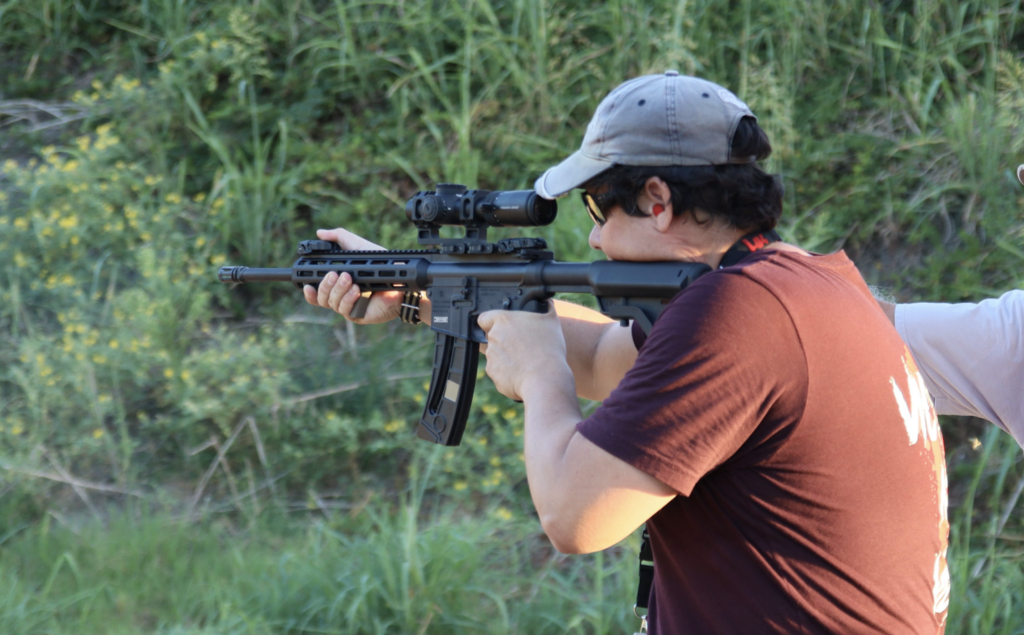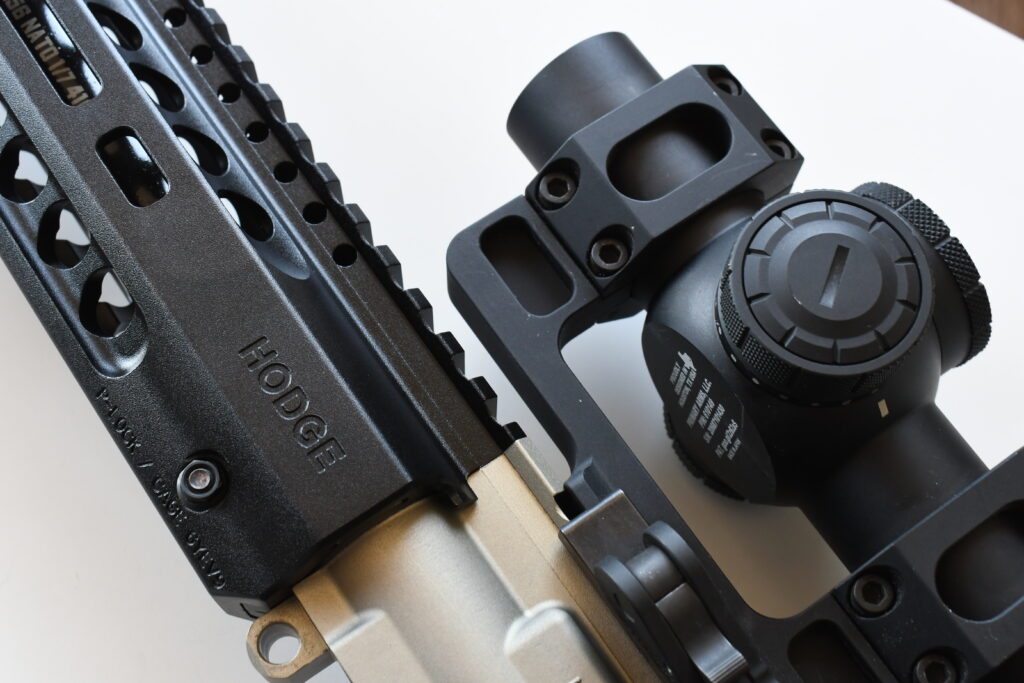Continued from Part 2. Primary Arms PLxC LPVO shown on a different carbine mounted on a Primary Arms GLx 30mm 1.5″ mount.
My Critiques Of the Primary Arms PLxC LPVO

Overall, I have a good impression of the Primary Arms PLxC, and I really like its build quality and attention to detail. The scope’s field of view at low power is quite generous, and the fact that Primary Arms Optics was able to compress the functionality of a larger full-size 34mm LPVO into a shorter and thinner 30mm body is quite impressive in of itself.
Advertisement — Continue Reading Below
I like the quality of its optical glass and the way it transmits light. Chromatic aberration was minimal and not out of line with what I’ve seen with other—even more expensive—scopes. I also suspect that its “tight” eyebox and having to adjust the focus differently for shots with full magnification, as opposed to none, are part of the compromise of fitting all that glass into such a small package.
Twisting a focus ring and working on indexing the rifle and stock relative to the face more efficiently are not the end of the world. On top of that, the spinning magnification adjustment has a solid, quality feel to it.
In summary, the PLxC LPVO gets a solid thumbs up with regard to its physical qualities.
Advertisement — Continue Reading Below
The Chevron
I really appreciate the effort and thought behind the ACSS Griffin Mil M8 reticle, which does its best to take advantage of the best attributes an LPVO brings to the table. However, I’m personally not crazy about the floating chevron used as the central aiming point. After trying out the chevron with an open mind, I found it wasn’t for me.
The central aiming chevron is approximately 1 mil tall and 2 mils wide while its body is roughly ½ mil thick. This doesn’t matter much when shooting at large targets at shorter distances with the magnification on its lowest settings. But I find that the chevron is a compromise for finer precision aiming, especially with its ½ mil thickness.
At ½ mil thick, 1 mil tall and 2 mils tall, I think the ACSS Griffin’s chevron is too chunky and obstructs the target more than I’d like it to. For example, using my carbine with a 100-yard zero and M193 ammunition, I took it to the Cornerstone LPVO class. I know that my come-up for 200 yards is around 0.31. Yet, while shooting off a barricade with a bag during that course, I routinely missed more shots at the 200-yard 8-inch steel gongs than I care to admit.
Advertisement — Continue Reading Below
I kept “losing” the steel target within the ½ mil maw of the chevron without having a clear reference point. I’m of the opinion that the central aiming point on an optic like the PLxC should be no larger than 0.20 mil. Anything bigger runs the risk of obscuring specific points on a target in spite of the fact that LPVOs aren’t sniper scopes.


Advertisement — Continue Reading Below

The Horseshoe Ring And Illumination
I think the horseshoe ring in the ACSS Griffin Mil M8 reticle is an element that shooters will either love or hate. Factors would depend on the shooter’s needs and style of shooting, along with whatever they’re trying to accomplish with the PLxC.
In a twist of irony, I thought I would end up disliking how thick the horseshoe ring is on 8x. However, after seeing for myself how handy it could be when shooting Steel Challenge targets quickly on 1x, and also taking some shots at steel targets placed further back, I wouldn’t hesitate to bring this optic to a 2-gun or 3-gun style match.
Advertisement — Continue Reading Below
It is true that due to the first focal plane design of this PLxC variant, the horseshoe becomes quite prominent at full magnification. Measuring horizontally from outer edge to edge, the horseshoe ring is 10 mils wide. I estimated the thickness of its “line” to be approximately 0.75 mils wide.
There’s no doubt that some shooters will find the thicker line, along with its 10 mil wide span, to feel “busy” and with the potential to block or crowd out the field of view downrange. Ditto for the wind-shaped auto-ranging stadia.
The Horseshoe Ring is a Good Fit
After some internal deliberation, I finally decided on the horseshoe ring and its place in the ACSS Griffin Mil M8 reticle. It’s a good fit, especially in the context of this optic.
Advertisement — Continue Reading Below
I’ll elaborate: the illumination on the highest setting is visible in daylight but it’s not daylight bright. And the lack of nuclear cherry-red brightness is probably the most common complaint I’ve seen about the Primary Arms PLxC.
Truthfully, the internal components necessary to illuminate a first focal plane reticle to those extremely bright levels are so much more expensive. My educated guess is that if Primary Arms had gone that route, chances are that the PLxC would actually be in a different and more expensive price bracket.
Michael Branson from Gideon Optics (whose resume includes Primary Arms, too) goes into some detail about this in the podcast he recorded with our friends at Big Tex Ordnance. Therefore, I think the placement of the horseshoe ring in such a manner that makes it clearly useful and visible at 1x helps bolster the daylight visible illumination while still remaining useful.
Advertisement — Continue Reading Below
While the horseshoe’s 0.75 mil thick ring can potentially block the field of view downrange when fully magnified, in my experiences shooting past 275 yards, it wasn’t a concern for me.
With regards to the illumination issue, this could either make or break the optic, depending on the end-user and their specific needs. In my case, as a “regular guy” using the range during the weekends, the occasional carbine class, or at a match, the lack of daylight bright illumination isn’t a deal breaker.
I’m sure a patrol or SWAT officer employing an LPVO on his duty carbine might have different requirements and considerations as far as the brightness level and busy-ness of the optic’s reticle are concerned.
Advertisement — Continue Reading Below

The Takeaway
Primary Arms Optics has staked its reputation on offering products that work quite well for the money—the “value proposition” as it goes. However, over the past few years, Primary Arms has also been ramping up its product development among its higher-end offerings, and this new crop of compact LPVOs is part of these efforts.
Even though one may not agree 100% with the execution of the PLxC LPVO, it’s evident that Primary Arms put a lot of thought into the design and development of the optic. Physically, it’s well-made and has a great size and weight, clear glass, and a fairly “strong” magnification level.
I think reticle design and implementation ought to be its own philosophical field or even art form. Again, I appreciate the ingenuity, thought, and effort put into the ACSS Griffin Mil M8 reticle. But perhaps the reticle is trying to be a “jack-of-all-trades-master-of-none.” I think paring down the chevron or using a different type of central aiming point would have gone a long way.
I’m not defending the lack of brightness on the first focal plane PLxC, but this most likely entailed keeping costs competitive, as I explained above. And keeping that in mind, I don’t think it takes away any of the other wonderful qualities exhibited by the PLxC.
It’s also worth mentioning that at the beginning of summer 2024, Primary Arms also launched a second focal plane version of the PLxC LPVO—one that uses the ACSS Nova Fiber Wire reticle and has that cherry-red daylight bright illumination.















